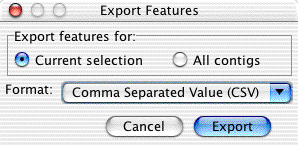
Sooner or later, you will probably want to use the data you processed or assembled in CodonCode Aligner in a different program. If all you want is the sequence of a single sample or a single contig, then copying the sequence in Aligner, and pasting it in your other program, may be all you need to do. For everything else, there is exporting. CodonCode Aligner allows you to export individual sequences, collections of sequences or contigs, whole assemblies, and features in a variety of different formats (if we are not supporting a format you need, please let us know!).
You can export the sequences from samples to FASTA-formated files, either as writing each sequence into an individual file, or writing all sequences into one single file. Samples that have chromatograms can also be exported to files in "SCF" format ("Standard Chromatogram Format"), which can be read by many other programs.
To export sequences, choose the samples you want to export in the project view, go to the "File" menu, and choose "Export - Samples...". This will bring up the following dialog:

Use the radio button at the top to select whether you want to export only the selected sample or all samples in the contig. Then, use the pull-down menu to select the file format, and click on the "Export" button. Next, Aligner will show you a "Save" file dialog where you can choose the destination of the exported file. For export of single files, you can also choose the file name. If you export to multiple files, for example when exporting SCF files, the names of the files will be determined from the sample names.
The default directory for exporting is a directory called "export_dir" in the project directory. Aligner will create this directory the first time it is needed. You can, of course, choose to export to a different directory.
Note that when you export files in FASTA format, Aligner will create a separate quality file for each output file created. The name of this file will be the name of the corresponding FASTA file, with ".qual" appended. The quality files contain the quality scores for each base in a FASTA-like format. You can look at the files in any text editor.
Exporting the "consensus" sequence of a contig or contigs is done in a very similar way. Select the contig(s) in the project view, go to the "File" menu, and choose "Export - Consensus Sequences...". One difference is that you cannot export consensus sequences in SCF format, since consensus sequences do not have trace data.
You can export Aligner projects for importing into other programs, for example the contig editor Consed. You can export entire Aligner projects, or parts of Aligner projects, for example single contigs.
First, select the contig(s) you want to export in the project window. Then, choose "Export Assembly..." from the "File" menu. This will bring up the following dialog:

After you click "Export", a "Save As" dialog will appear to let you choose where to save. If you are running OS X and have Consed installed, try to open the project you just exported in Consed!
Currently, the only supported format is the "ACE" format that is used by the Phred-Phrap-Consed package, and also supported by other contig editors. We plan to add support for other formats in the future. If you need a specific format, please let us know the format and the program that you need if for.
As you learned in the "Navigating" section of this quick tour, CodonCode Aligner lets you define "features" to allow you to quickly move to regions that are of interest to you, for example tags added by you or by programs like PolyPhred, areas of low coverage, and so on. For the times where you may want to use a list of this features in a different program like Excel, Aligner lets you export features to text files.
To try this out:
This will bring up the following dialog:

In the "Format" drop down menu, select "Comma Separated Value (CSV)", then press the "Export" button. In the "Save" dialog that opens up, select a destination and name for the file.
Next, you can look at the file in a text editor like NotePad, or a spreadsheet program like Microsoft Excel (you may have to select "All document" as the file type in the "Open" dialog to be able to see or open the file). Here is an example what the file looks like in Microsoft Excel:

For an example how CodonCode Aligner would analyze the mutations here, keep reading - we'll cover that in the next section.
Aligner Home Page - Quick Tour Start - Previous - Next: Finding Mutations